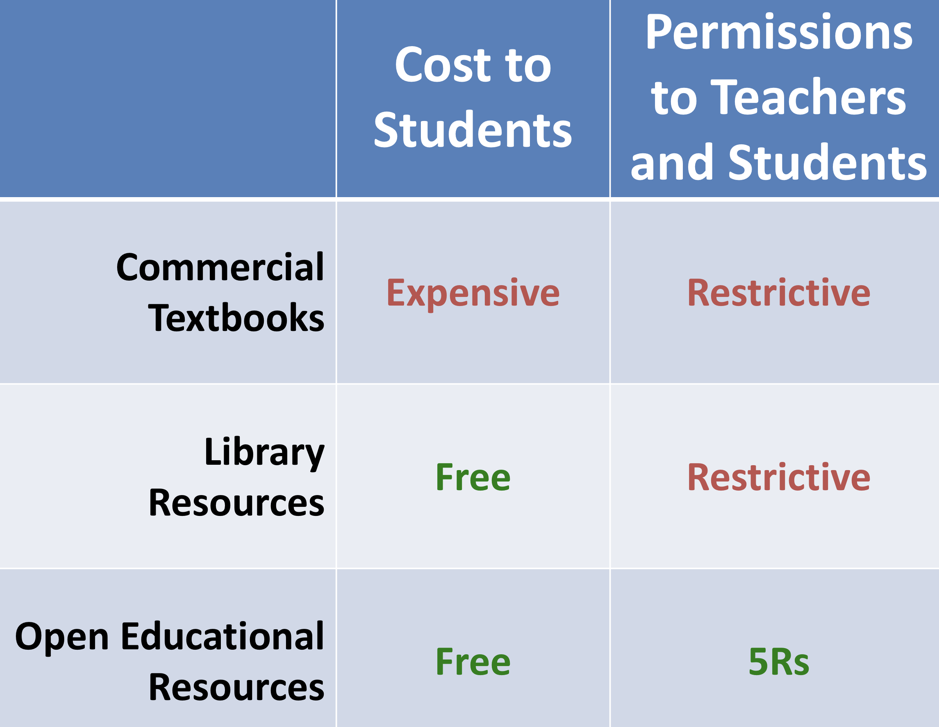Creative Commons for Educators
27 OER, Open Textbooks, Open Courses
Introduction
Open education is an idea, as well as a set of content, practices, policy, and community which, properly leveraged, can help everyone in the world access free, effective, open learning materials for the marginal cost of zero. For the first time in history, educators around the world can create, open, and share high quality, effective learning materials with everyone who wants to learn. The key to this transformational shift in learning is Open Educational Resources (OER). OER are education materials that are shared at no cost with legal permissions for the public to freely use, share, and build upon the content.

OER are possible because:
- education resources are (mostly) born digital and digital resources can be stored, copied, and distributed for near zero cost;
- the internet makes it simple for the public to share digital content; and
- Creative Commons licenses make it simple and legal to retain copyright and legally share education resources with the world.
Because we can share effective education materials with the world for near zero cost, many people argue that educators and governments who support public education have a moral and ethical obligation to do so. This argument roots in the premise that education is fundamentally about sharing knowledge and ideas. Creative Commons believes OER will replace much of the expensive, proprietary content used in academic courses. Shifting to this model will generate more equitable economic opportunities and social benefits globally without sacrificing quality of education content.
Learning Objectives
- Define “open” in the context of open educational resources (OER)
- Differentiate between OER, open textbooks, open courses, and MOOCs
Big Question – Why it Matters
Does it seem reasonable that education in the age of the internet should be more expensive and less flexible than it was in previous generations? As people and knowledge are increasingly networked and available online, what will it mean for learning, work, and society?
As economies become increasingly global and networked, the skills and knowledge required to successfully acquire and keep good jobs require a higher education. All national governments invest in and have strategic goals for how their public education systems can support individuals, families, and the broader society.
While many interesting and useful experiments are occurring outside formal education, the degrees, certificates, and other credentials awarded by formal institutions are still critically important to the quality of life of many people around the world.
As noted, formal education, even in the age of the internet, can be more expensive and less flexible than ever. In many countries, publishers of education materials overcharge for textbooks and other resources. As part of their transition from print to digital, these same companies have largely moved away from a model where learners purchase and own books to a “streaming” model where they have access for a limited time.
Further, publishers are constantly developing restrictive technologies that limit what learners and faculty can do with the resources they have temporary access to, including inventing novel ways to prohibit printing, prevent cutting and pasting, and restrict the sharing of materials between friends.
Personal Reflection – Why it Matters to You
What impacts have the rising costs and decreased flexibility of education materials had on you and those you know? What role do you imagine all-rights-reserved copyright and related laws have played in driving up costs and driving down flexibility for learners and teachers?
Acquiring Essential Knowledge
OER and Open Textbooks
To begin, watch this video Why OER? (time 03:48)
Open Educational Resources (OER) are: teaching, learning and research materials in any medium that reside in the public domain or have been released under an open license that permits no-cost access, use, adaptation and redistribution by others.
Or you could use this less technical definition to describe OER to someone:
OER are education materials that can be freely downloaded, edited, and shared to better serve all students.
In contrast to traditional education materials, which are constantly becoming more expensive and less flexible, OER provide everyone, everywhere, free permission to download, edit, and share them with others. David Wiley provides another popular definition, stating that only education materials licensed in a manner that provide the public with permission to engage in the 5R activities can be considered OER.
The 5Rs include:
- Retain – permission to make, own, and control copies of the content (e.g., download, duplicate, store, and manage)
- Reuse – permission to use the content in a wide range of ways (e.g., in a class, in a study group, on a website, in a video)
- Revise – permission to adapt, adjust, modify, or alter the content itself (e.g., translate the content into another language)
- Remix – permission to combine the original or revised content with other material to create something new (e.g., incorporate the content into a mashup)
- Redistribute – permission to share copies of the original content, your revisions, or your remixes with others (e.g., give a copy of to a friend)
The easiest way to confirm that an education resource is an *open* education resource that provides you with the 5R permissions is to determine that the resource is either in the public domain or has been licensed under a Creative Commons license that permits the creation of derivative works – CC BY, CC BY-SA, CC BY-NC, or CC BY-NC-SA.
OER comes in all shapes and sizes. A piece of OER can be as small as a single video or simulation, and can be as large as an entire degree program. It can be difficult, or at least time consuming for teachers to assemble OER into a collection comprehensive enough to replace an all rights reserved copyright textbook. For this reason, OER are often collected and presented in ways that resemble a traditional textbook in order to make them easier for instructors to understand and adopt. The term “open textbook” simply means a collection of OER that have been organized to look like a traditional textbook in order to ease the adoption process. To see examples of open textbooks in a number of disciplines, visit OpenStax,the Open Textbook Library or the BC Open Textbook Project. Other times, OER are aggregated and presented as digital courseware. To see examples of open courseware, visit the Open Education Consortium and MIT OCW.
In addition to demonstrating that learners save money when their teachers adopt OER, research shows that learners can have better outcomes when their teachers choose OER instead of education materials available under all rights reserved copyright.
The idea of OER is strongly advocated by a broad range of individuals, organizations, and governments, as evidenced by documents like the Cape Town Open Education Declaration (2007), the UNESCO Paris OER Declaration (2012), and the recently adopted UNESCO Ljubljana OER Action Plan (2017).
OER vs. Free Library Resources
Teachers and professors typically use a mix of all-rights-reserved commercial content, free library resources, and OER in their courses. While the library resources are “free” to the learners and faculty at that institution, they are (a) not “free” as the institution library has to pay to purchase or subscribe to them, and (b) not available to the general public. This chart describes the cost to learners and the legal permissions available to teachers and learners for each of these types of educational resources.

OER in Primary / Secondary (K-12) vs. Tertiary (Higher Education)
OER is used in all sectors of education. How OER is produced and adopted, however, is often different depending on the level of education in which you work.
In general, tertiary (higher education) faculty are more likely to:
- have time, resources and support to produce and revise educational resources,
- own the copyright to content they create (though it depends on their contract with the college / university), and
- make unilateral decisions (see academic freedom) regarding what content is used in their courses.
As such, tertiary (higher education) faculty are often OER producers and can decide whether or not to adopt OER in their courses. OER adoption in tertiary (higher education) tends to occur one faculty member at a time. Given this opportunity, it is critical faculty be given time, resources and support for the creation and adoption of open education content and a shift to open education practices / pedagogy. Example: British Columbia Faculty wrote an Open Textbook
In general, primary / secondary (K-12) teachers are less likely to:
- have time, resources and support to produce and revise educational resources,
- own the copyright to content they create (though it depends on their contract with the school / district), and
- make unilateral decisions regarding what content is used in their curriculum.
As such, OER adoption in primary and secondary (K-12) schools tends to occur at the district or school, rather than the individual teacher level. Example: Open policies in New Zealand schools
Open Educational Resources (a very brief timeline)
While there isn’t enough space in this Certificate give a comprehensive overview of the “History of Open Education,” here are several of the pivotal events that contributed to the growth of the open education movement. (If you know of additional critical events to include, please tell us and we will update the timeline. Thanks!)
- 1969 – UK Open University opens
- 1983 – Free software movement founded with launch of GNU
- 1989 – World Wide Web
- 1997 – MERLOT
- 1998 – U.S. Copyright Term Extension Act
- 1998 – “Open content” term is coined and Open Content License released
- 1999 – Open Publication License released
- 1999 – Connexions launches (renamed OpenStax in 2012)
- 2001 – Wikipedia
- 2001 – Creative Commons founded
- 2001 – MIT Courseware
- 2002 – Budapest Open Access Initiative
- 2002 – Creative Commons licenses launched
- 2002 – UNESCO coined the name Open Educational Resources
- 2004 – First annual Open Education Conference
- 2005 – OpenCourseWare Consortium formed (renamed the Open Education Consortium in 2014)
- 2006 – WikiEducator
- 2007 – Cape Town OER Declaration
- 2007 – OER Commons
- 2007 – Wiley and Couros experiment with “open courses”
- 2008 – Opening Up Education published
- 2008 – Connectivism and Connected Knowledge
- > 2000 learners participated, leading to the term “massive open online course” or MOOC. Watch this video describing MOOCs:”What is a MOOC?” video (4:26) by Dave Cormier, CC BY 3.0
- 2012 – OpenStax releases first open textbook
- 2012 – UNESCO OER Paris Declaration
- 2013 – OERu launched
- 2017 – UNESCO 2nd World OER Congress
- 2018 – UNESCO drafting an OER Recommendation
Final Remarks
OER, whether organized as open textbooks or opencourseware, provide teachers, learners, and others with a broad range of permissions that make education more affordable and more flexible. These permissions also enable rapid, low-cost experimentation and innovation, as educators seek to maximize access to effective educational resources for all.

